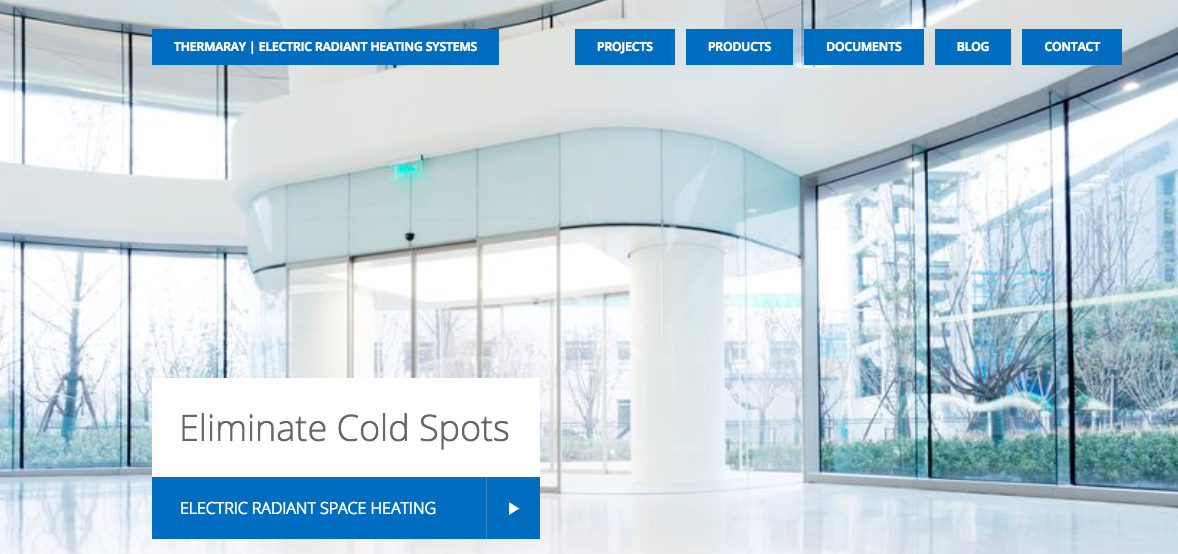SEO and Inbound Marketing in Construction Industry
[Editor’s Note: This is a guest post by two St. Thomas University Students: Alexandra Swift and Allison Bruder. It was completed as part of a course assignment in the fall of 2017]
In this interview with ThermaRay’s president Kevin Kilbride, we explored the topics of inbound marketing, search engine optimization and global marketing. ThermaRay was founded in 1985, and since then has been providing sustainable heating solutions with a wide range of electric radiant systems, including our radiant ceiling, architectural series, floor warming, underfloor warming and earth thermal storage products. The topic of this interview was inbound marketing, and ThermaRay’s use of this tactic in marketing both in Canada and globally.
Mr. Kilbride explained that ThermaRay is not fully focused on inbound marketing because they haven’t been able to find a vehicle that will drive potential customers to their website the way they would like based on their industry. The problem with their online search catalogue was that if you don’t know what you’re looking for, how are you supposed to search it and go find it? In this question and answer, Mr. Kilbride explained his company’s use of SEO and other inbound marketing strategies specific to ThermaRay.
What forms of social media does your company use?
We have a LinkedIn page, Facebook page a web site of course and I have a Twitter account. The website is the real focus for us. We also occasionally use YouTube to direct people for project installations. There are also a number of search engines, that are used as a resource. As well as online courses that are used to offer courses internationally.
What form of social media do you find the most effective?
Our website by far is the most effective. We use YouTube to direct people to see the odd project installation but that’s it. There are other forms of social media when you are in the business-to-business sector – online searchable catalogues, on-line courses that have been the most effective for us. Our website is the most effective because when people need the services we offer, such as homeowners, they often just google what they need and find us.
What steps do you take prior to sending out messages for marketing?
We tailor the message according to the audience. So an email blast to architects will be based more on the design aspects than say to an engineer who wants to know how it was installed and what problem did it solve for him. A potential problem that comes along with sending out messages is the area of spam email. You can buy databases but with junk folder filters and in Canada at least, spam being illegal it is very difficult to do email blasts. The way we can do it is via our presentations. Attendees on-line or face-to-face have to sign in and that gives us permission to send them emails, newsletters etc… until they unsubscribe. Yet I still hear from organizations willing to sell us a database of targeted individuals. Assuming it’s legal in the use to “spam” most people don’t like it and you’ll end up with a negative view of your company. This makes for a strong case to have an inbound marketing program.
What channels do you find most effective?
Website SEO works well for us. We rank in the first page in Canada in the US by using keywords that the industry is using in search engines.
What is your primary audience?
We have several audiences. In the construction industry, we work with architects but we also have to work with their mechanical engineers who are responsible for the heating, ventilation and air conditioning. So even though we sell the idea to the architect, we have to sell it to the engineer because he can squash the use of our product. In the residential side, we sell primarily to the homeowner but again the builder and electrical contractor are influencers so we have to be sure they are on board as well.
You mentioned that your company is not as focused on inbound marketing, why is that?
Other than SEO, we have yet to find a vehicle that will drive potential customers to our site. The problem we discovered though using an online searchable catalogue is that if you don’t know what you’re looking for, how do you know to go look for it? So if you need doors or windows, that’s an easy find. But how do you know when you should be using a radiant heating system instead of a conventional heating system? There is an education component here. So as well listed one maybe on some of these type of searchable product lists, you have to know what it is you’re looking for. When someone does, they tend to use Google and that’s how we get found out.
ThermaRay is a company based out of New Brunswick, but has expanded worldwide. How did you reach such a large consumer base from this small province?
We’re still a pretty small player, but that gives us an advantage. We are more nimble, more responsive to clients. We’ve had some success with local dealers promoting our products and we get the odd international customer looking for what we have. We have also worked with Opportunities New Brunswick to help grow our market.
What do you believe is the number one-way people hear about your company?
There’s no #1 method. We use SEO, we have an online course that is recognized by the American Institute of Architects so that gives us some credibility, we then do presentations to groups of architects and engineers and some plain old face-to-face selling.
ThermaRay has been involved in a few trade shows, how do you think these have helped your company’s marketing? And what do you think would be more effective?
There are consumer trade shows but there are also business trade shows. There are local ones and national ones. However, not every show has the same caliber so they are not all as effective, they tend to be very specific. In regards to trade shows, there is some give and take, it depends on the show and the product you have. I will generally not do a trade show unless I have interest in the local market. The problem with trade shows is that they are very expensive and you have limited time to talk to someone, so with a simple product it is more effective, but when your product is specific, you do not always get the chance to have a deeper conversation with a potential customer. Instead of a trade show, some larger companies have started hosting small events for their customers with drinks and food, these provide a more relaxing setting and allows for more time to connect and explain things.
Have you ever used Google Analytics to track your company’s search engine traffic? What do you do with this information?
Yes, we use them quite a bit. We overhauled our website earlier this year and we noticed a drop so we’re going to focus more on tweaking the word search on the site. We also use the analytics to find out what words people are using for their searches. Just because we call our product x, it may go by a different name by the general public. So for example, we have a floor warming system but the bulk of people call it floor heating so we want to know that.
[Editor’s Note. We thank Alexandra and Allison for the work they did and contributing to our blob.


